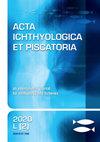The time-area fishing closure impacts on fish stock; Qiantang River before and after a four-month fishing closure
IF 1
4区 农林科学
Q3 FISHERIES
引用次数: 1
Abstract
Fishing closures, commonly used to manage fisheries’ catch, involve temporarily closing a body of water to particular fishing gears to control fishing effort and protect feeding and spawning areas. In recent years in Qiantang River of China, with the socio-economic development, protection of fish stock has become increasingly urgent. The year 2019 was the first year that Qiantang River was included in the unified fishing ban system for the south of Yangtze River basin. Here, fish captures and hydroacoustic surveys were carried out in the research area of Qiantang River in order to present comparative descriptions of the dominant fish species, the temporal changes of fish size, density, biomass, and distribution affected by the four-month fishing closure in 2019. The results showed that Pseudobrama simoni (Bleeker, 1864) was the most dominant species both before and after the closure by using the traditional capture method. The mean target strength (TS) of overall fish after closure was –50.28 ± 0.19 dB, which was lower than that before, resulting in a significantly shorter derived mean length (13.42 ± 0.74 cm). The mean fish density and calculated biomass after closure were both significantly higher than that before it. More than 50% of fish species were distributed in the water of 5–20 m depth after the closure, which likely occurred in water deeper than 20 m before. Meanwhile, fewer outliers were found in different depth categories after closure. It is concluded that the four-month closure in 2019 had a positive effect on fish size, density, and biomass, leading to protection of pelagic fishes and a more even distribution of fish.时间-区域捕鱼关闭对鱼类种群的影响;钱塘江禁渔前后4个月
通常用于管理渔业渔获量的捕鱼关闭包括暂时关闭特定渔具的水体,以控制捕鱼活动并保护觅食和产卵区。近年来,在我国钱塘江流域,随着社会经济的发展,鱼类种群的保护日益迫切。2019年是钱塘江被纳入江南流域统一禁渔制度的第一年。在这里,在钱塘江研究区进行了鱼类捕获和水声调查,以比较描述2019年四个月休渔影响的优势鱼类物种、鱼类大小、密度、生物量和分布的时间变化。结果表明,采用传统的捕捉方法,无论是在封育前后,西莫尼假布拉马(Bleeker,1864)都是最具优势的物种。闭合后,整体鱼类的平均目标强度(TS)为-50.28±0.19 dB,低于闭合前,导致推导的平均长度显著缩短(13.42±0.74 cm)。封控后的平均鱼类密度和计算生物量均显著高于封控前。超过50%的鱼类分布在封控后5–20米深的水中,这可能发生在封控前20米以上的水中。同时,闭合后在不同深度类别中发现的异常值较少。结论是,2019年为期四个月的关闭对鱼类的大小、密度和生物量产生了积极影响,从而保护了中上层鱼类,使鱼类分布更加均匀。
本文章由计算机程序翻译,如有差异,请以英文原文为准。
求助全文
约1分钟内获得全文
求助全文
来源期刊

Acta Ichthyologica Et Piscatoria
FISHERIES-ZOOLOGY
CiteScore
2.20
自引率
0.00%
发文量
31
审稿时长
>12 weeks
期刊介绍:
ACTA ICHTHYOLOGICA ET PISCATORIA (AIeP) is an international, peer-reviewed scientific journal that publishes articles based on original experimental data or experimental methods, or new analyses of already existing data, in any aspect of ichthyology and fisheries (fin-fish only).
 求助内容:
求助内容: 应助结果提醒方式:
应助结果提醒方式:


